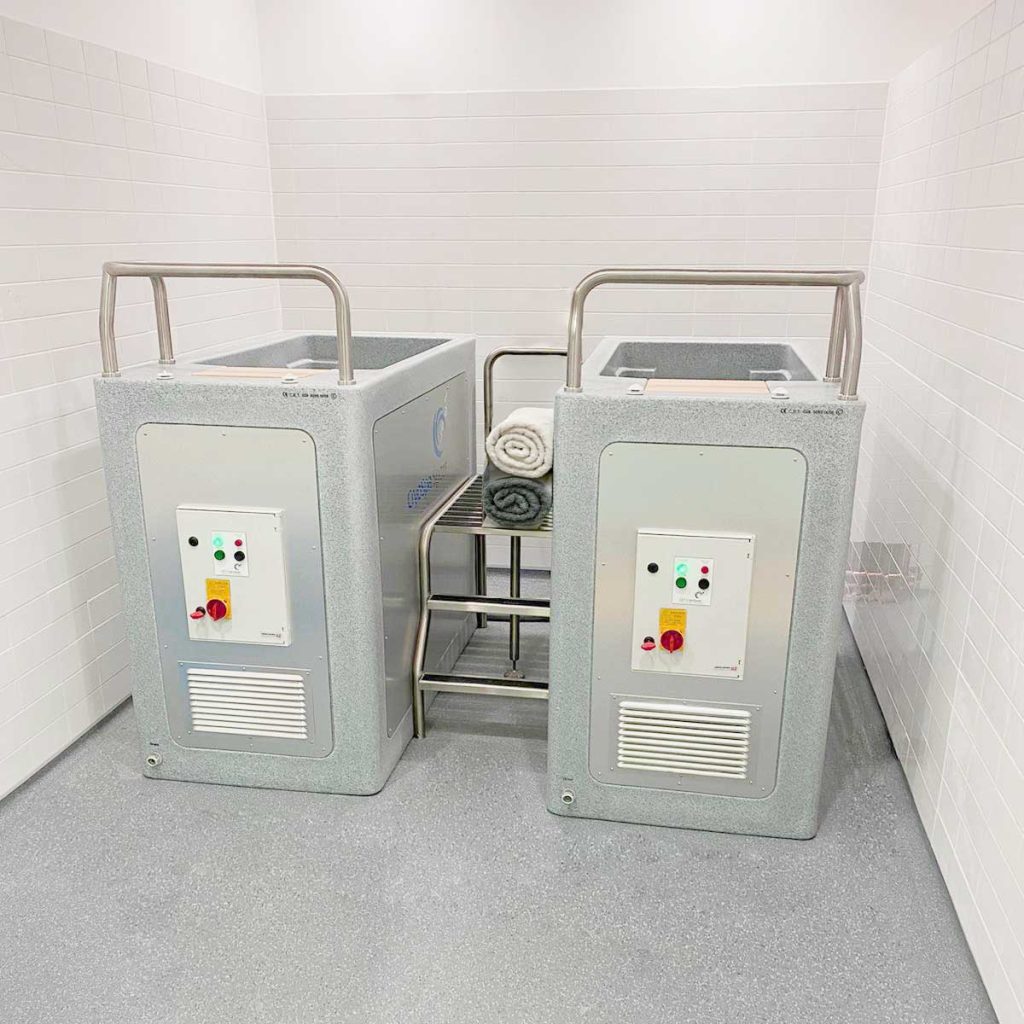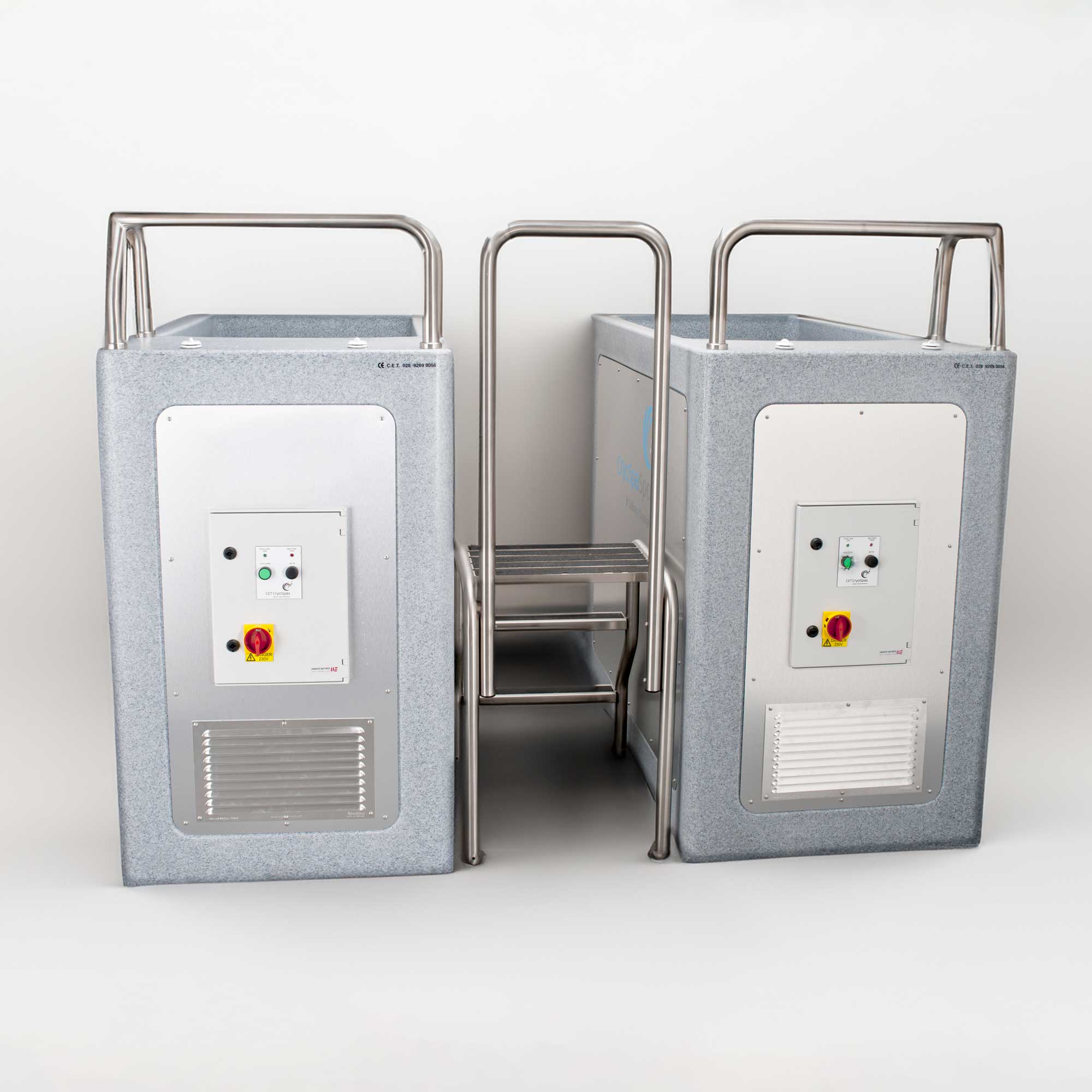Team CryoSpa Pro
The Team CryoSpa Pro ice bath helps accommodate individual athlete preferences while enabling a whole squad of players to be processed quickly post-match or after training.
- TEAM CRYOSPA PRO
Team Ice bath for rapid recovery of a squad of athletes.
The Team CryoSpa Pro consists of two CryoSpa Pro ice baths with shared central steps.
Each CryoSpa Pro can accommodate 2 to 4 athletes enabling the whole squad of players to get through quickly, saving time post match or post training.
The temperature of each CryoSpa Pro salt-water cold tub can be individually controlled down to 1°C / 34°F, which enables you to set different temperatures in each one to accommodate individual athlete preferences.

Maximise your performance with the Team Ice Bath
Process more players in less time and benefit from the same recovery modalities used by elite teams such as AC Milan, Bayern Munich, Legia Warsaw, Manchester City FC, Fulham FC, Glasgow Warriors, Wasps Rugby, Toronto Blue Jays, FC Bruges, Brooklyn Nets, Manchester United, Anderlecht & Wimbledon to name a few.
The benefits of the CryoSpa Pro are numerous for high performance athletes: the digitally controlled temperature delivered via a high-performance chiller, combined with the unique positioning of the jets maximises the therapeutic effect keeping players on top of their game. All these factors form an integral part of the recovery strategy, delivering optimum athlete recovery, which minimises fatigue and lowers the risk of injury.

Features Include
- Temperature range from 1C to 14C [34F to 55F].
- Hydrostatic pressure and 20 Massage Jets per CryoSpa.
- Penetrating cold for effective therapy and short treatment times.
- High salt concentration aids infection control.
- High spec filtration keeps the water clear.
- High quality low temperature digitally controlled chiller.
- Stainless steel safety rail and steps.
- Two year guarantee on spa body.
Benefits for Athletes
- Shorter recovery time post-exercise.
- Reduce fatigue and lower the risk of injury.
- Low temperature salt-water facilitates faster resolution of soft tissue injuries.
- Treat muscle and joint soreness and soft tissue strains.
- Combat hypoxic injury due to excessive inflammation.
- Promote neural and cardio vascular system recovery.
- Minimise delayed onset muscle soreness (DOMS)
Benefits for Staff
- Easy to maintain saving on labour and cost.
- Effective filtration keeps the water clear.
- Digitally controlled chiller maintains the water temperature.
- Quiet operation.
- Short treatment times due to intense cold.
You can vary the therapy according to your requirements
- Simply chill in the water without the massage jets on for a less intense ice bath experience.
- Turn on the massage jet pump for a penetrating cold to provide the optimum post-exercise recovery.
- Adjust the air nozzles to minimize or maximize the massage effect.
- Opening the air nozzles fully maximizes the power of the jets.
Four Treatment Modalities
- Sit on top for ankle therapy
- Stand on step for submersion to mid-thigh
- Stand in deep end for submersion to waist depth
- Sit on step for full body submersion
Power
- 230v / 1 / 50hz
- 230v / 1 / 60hz
- 115v / 1 / 60hz
Dimensions of each Spa
- Spa: c. 1.55m x 0.8m x 1.2m [L x W x H] c. 61″ x 32″ x 48″
- Steps: c. 0.55m wide (c. 22″)
Weight
- Empty: c. 200 kg / 441 lbs
- Full: c. 750 kg / 1650 lbs
Jets
- 20 Massage Jets
- 1.5kw Jet Pump
Steps & Rails
- Stainless Steel Steps and Safety Rails
Chiller
- Low noise low temperature chiller
- Each CryoSpa is supplied with one chiller
Optional
- Stainless steel brackets for wall mounting the chiller.
E.&O.E.

Request Information
Complete our form

Frequently Asked Questions
Why do footballers take ice baths?
It is quite commonly stated that ice baths reduce lactic acid but this is not the case. Lactic acid, or lactate, occurs when the body gets into an oxygen debt situation i.e. is functioning anaerobically. When the level of activity ceases, or reduces sufficiently, in simple terms the body can acquire surplus oxygen, which is used to convert the lactic acid back to its normal pyruvate / pyruvic acid state.
According to Gregory Dupont, who presented at the FIFA sponsored Sports Injury Summit held at Wembley in 2013 the main precursor of injury is fatigue. Further research investigated the common strategies for aiding recovery, minimising fatigue and, thereby, lowering the risk of injury.
The conclusion was good diet, good sleep, hydration [all lifestyle factors] plus cold water immersion were the main scientifically proven methods of aiding recovery and minimising fatigue.
The other side of the coin is performance and here we find that fatigue inhibits performance. So if we can manage fatigue by improving fitness and aiding recovery the outcome is improved performance and lowered risk of injury.
What is the optimum temperature for ice bath recovery?
Ice bath therapy is a factor of time and temperature. The higher the temperature the longer is the required duration.
In the past most researchers used a time of 10, 15 or even 20 minutes at typically 10°C to 15°C (50F to 59F). The problem with the longer sessions is that the temperature is not maintained unless you constantly add more ice. And the colder water floats at the top unless you constantly stir the water. In practice, most people sit still as the body warms the water around the skin making it more tolerable.
However, this strategy can be counter-productive as the generally recognised therapeutic tissue temperature of 12°C to 15°C cannot be readily achieved in traditional ice baths.
Modern ice baths do not use ice but have a digitally controlled chiller maintaining the temperature at a pre-set level throughout the therapy session. This enables both lower temperatures and shorter sessions to achieve an improved therapeutic effect.
Also, when the ice bath has jets, like the CryoSpa, there is chilling by both conduction and convection (wind chill) leading to a much more penetrating cold and ensuring the tissue is chilled to the therapeutic level.
Many elite football clubs, rugby clubs and Olympic training facilities are now using temperatures in the 6°C to 10°C (42F to 50F) range with some even as low as 4°C (39F). When combined with the windchill effect the therapy sessions are most often in the 3 to 6 minute range.
Should I use an ice bath after every training session?
The debate on the use of ice baths, or cold-water immersion, rages on with many pundits claiming it is good and others claiming it is not.
The answer depends on the stage of training the athlete is at and the main objective of that training block.
If you are in the pre-competition phase of training and the main objective is to build power then there is research indicating that ice baths (and other micro-strategies for minimising training responses, such as anti-oxidant supplementation) during this phase may limit the adaptation effect i.e. your muscles will adapt to the increased workload faster if the body is allowed to contend with the inflammation and micro-tears naturally without the intervention of cold water immersion.
However, if you are tapering the workload toward an upcoming competitive event or if you are in the competitive part of the season then the main focus shifts to recovery and minimising fatigue rather than power building and in these circumstances research indicates the use of ice baths will be beneficial.
The key word here is fatigue. Fatigue is the main precursor of injury and is also a major performance inhibitor. Consequently, the fitness coach’s objective is to maximise fitness and minimise fatigue in order to maximise performance and lower the risk of injury.
And the main strategies for combating fatigue: Good Sleep, Good Diet, Hydration and Cold Water Immersion (per Gregory Dupont, FIFA Sports Injury Summit, Wembley Stadium, April 2013).
The argument is further complicated in team sports where skill, tactics and pre-planned moves need to be coached on the training pitch. In these sports the coach will want the players to be mentally alert and physically prepared to benefit fully from the coaching session, not hobbling around only partially recovered from the previous day’s training. In this instance, there may be a conflict of interest where the fitness coach is trying to maximise adaptation while the team coach wants the players recovered sufficiently to benefit fully from the training session, therefore, CWI may be strategically used to fit the on-going training session plans rather than eliminated to cater for both objectives.
So are ice baths good or bad?
The answer depends on the part of the season and the main objective of the current training regime. In the competitive phase of the season the use of ice baths will help minimise fatigue and aid recovery, thereby improving performance and lowering the risk of injury. In the pre-season, or power-building phase, of training the use of ice baths may adversely affect the adaptive response.
So, as with most tools in the athlete preparation toolbox, it is how the coach uses CWI to best effect, rather than whether it is appropriate to use it or not!
Browse common questions that may give you the answer. Have a question not here? Contact Us.